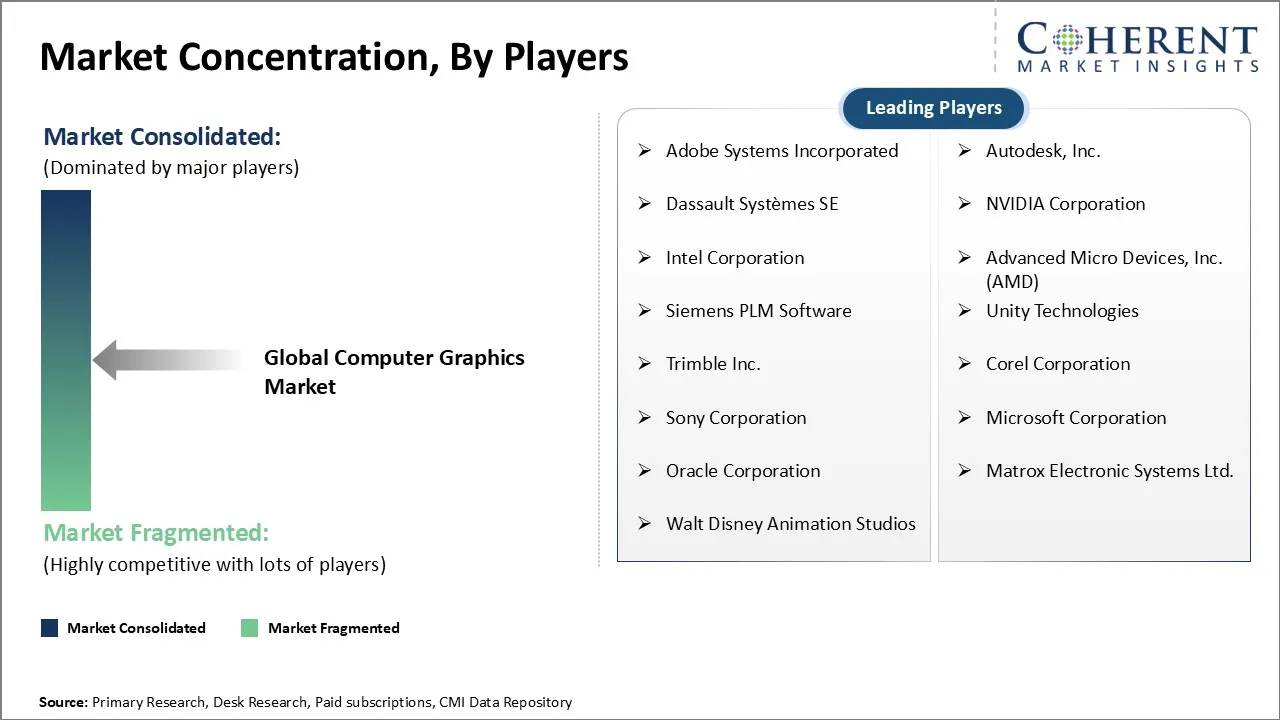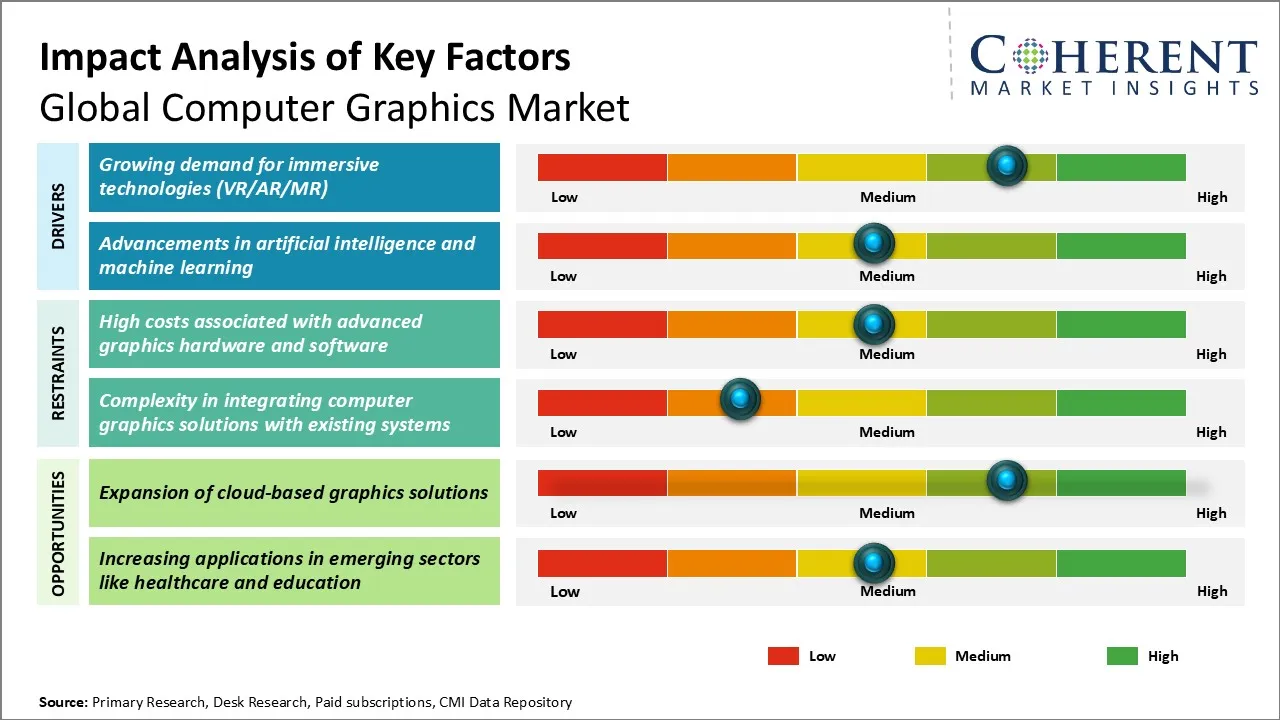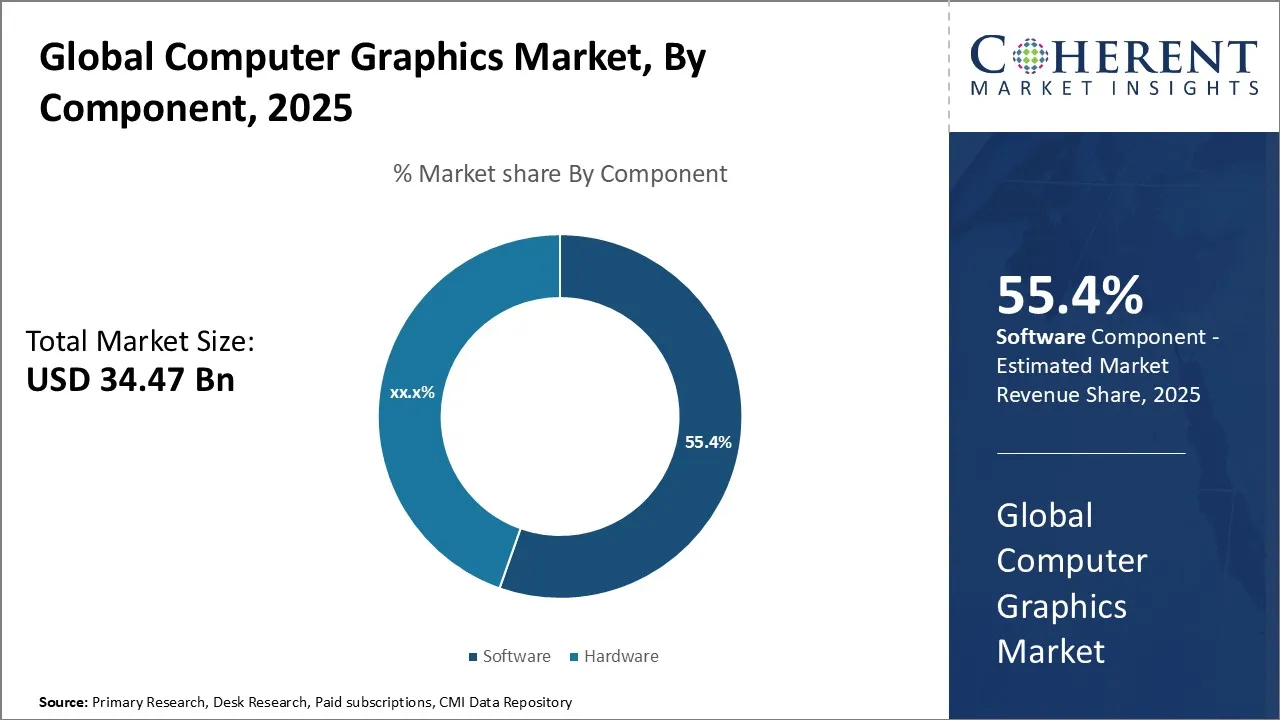Global Computer Graphics Market Size and Forecast – 2025-2032
The Global Computer Graphics Market is estimated to be valued at USD 34.47 Bn in 2025 and is expected to reach USD 52.52 Bn by 2032, exhibiting a compound annual growth rate (CAGR) of 6.2% from 2025 to 2032.
Key Takeaways of the Global Computer Graphics Market:
- The software segment is expected to lead the market holding an estimated share of 55.4% in 2025.
- The Computer-Aided Design (CAD) segment is projected to dominate with a share of 34.3% in 2025.
- Asia Pacific is estimated to lead the market with a share of 33.5% in 2025. North America, holding a share of 27.4% in 2025, is projected to be the fastest growing region.
Market Overview:
The computer graphics market is experiencing significant growth due to the increasing demand for visually appealing content across various industries such as gaming, entertainment, advertising, and product design. Hardware and software technologies in the market are seeing rapid advancements. Also, virtual reality (VR) and augmented reality (AR) applications are becoming more popular. These trends are adding to market growth. Additionally, the rising trend of cloud-based solutions and the increasing use of computer graphics in the healthcare sector for medical imaging and visualization are expected to create new opportunities for market players in the coming years.
Current Events and their Impact
|
Current Events |
Description and its impact |
|
Semiconductor Chip Supply Chain Disruptions |
|
|
Accelerating Adoption of Virtual Reality (VR)/Augmented Reality (AR)/Mixed Reality (MR) |
|
Uncover macros and micros vetted on 75+ parameters: Get instant access to report
Global Computer Graphics Market Insights, by Component – Software leads due to the increasing demand for advanced visualization and design tools
The software segment of the global computer graphics market is expected to hold a leading share of 55.4% in 2025. Software technologies are seeing a lot of advancements, making possible the development of more sophisticated and user-friendly graphics software. These modern software solutions offer many features and tools to help users create detailed and realistic visual content. Educational institutions are also adding computer graphics courses into their curricula to prepare students for careers in different fields, such as architecture and digital media.
Virtual and augmented reality technologies are also rapidly becoming popular. These technologies rely heavily on computer graphics software to create realistic and engaging virtual environments. Furthermore, the proliferation of mobile devices and the increasing availability of mobile graphics software have expanded the reach of computer graphics beyond traditional desktop platforms. Mobile graphics software allows users to create and manipulate visual content on smartphones and tablets, opening up new opportunities for creative professionals and enthusiasts alike.
Global Computer Graphics Market Insights, by Application – Computer-Aided Design (CAD) leads due to its extensive use in various industries for product design, prototyping, and visualization
The Computer-Aided Design (CAD) segment is the largest contributor to the global computer graphics market, holding an estimated share of 34.3% in 2025. CAD software enables designers and engineers to create detailed 2D and 3D models of products, buildings, and infrastructure, facilitating efficient design processes and reducing the time and cost associated with traditional manual drafting methods. As businesses strive to develop more innovative and competitive products, they rely on advanced CAD software to create intricate designs and simulate product performance before manufacturing. Moreover, the integration of CAD with other technologies, such as computer-aided manufacturing (CAM) and computer-aided engineering (CAE), has further enhanced the value proposition of CAD software.
The computer-aided design (CAD) segment also benefits from the growing trend of digital transformation across industries. As businesses increasingly adopt digital technologies to improve their operations and competitiveness, the demand for CAD software that can integrate with other enterprise systems, such as product lifecycle management (PLM) and enterprise resource planning (ERP), is expected to rise.
Role of Artificial Intelligence (AI) in the Market
Artificial Intelligence (AI) is playing a transformative role in the global computer graphics market by automating and enhancing key creative and technical processes. From procedural content generation to intelligent image upscaling and real-time rendering, AI is significantly reducing production time and boosting productivity across industries like gaming, animation, architecture, and simulation. Deep learning models are now used to automate tasks such as texture mapping, facial animation, and environment rendering—enabling artists and developers to focus on creativity rather than manual detail work. Moreover, AI-powered tools are increasingly integrated into mainstream design software, reshaping workflows and skill requirements.
NVIDIA’s Deep Learning Super Sampling (DLSS) technology uses AI and machine learning to generate high-resolution images from lower-resolution inputs in real time. This has revolutionized visual fidelity in gaming by delivering 4K-like visuals with significantly lower computational demands—making immersive, cinematic experiences accessible even on mid-range hardware.
Regional Insights

To learn more about this report, Download Free Sample
Asia Pacific Computer Graphics Market Analysis and Trends
Asia Pacific, holding a share of 35.2% in 2025, is expected to dominate the global computer graphics market. The region's rapid economic development, increasing disposable incomes, and rising demand for visually appealing content have fueled the market's expansion. Countries like China, Japan, and South Korea have emerged as significant players, with their gaming and animation industries experiencing tremendous growth. The presence of large consumer markets and the availability of skilled labor have attracted global companies to establish their presence in the region. Moreover, government initiatives to promote digital content creation and the adoption of advanced technologies have further accelerated the growth of the computer graphics market in Asia Pacific.
North America Computer Graphics Market Analysis and Trends
North America, holding a share of 27.4% in 2025, is projected to exhibit the fastest growth in the global computer graphics market. The region boasts a robust market ecosystem, with the presence of major technology companies, such as Intel, and a thriving gaming industry. The region's strong emphasis on research and development, coupled with favorable government policies and investments, has further propelled its leadership in the market. Additionally, the widespread adoption of computer graphics across various industries, including entertainment and healthcare, has contributed to region's dominance.
Global Computer Graphics Market Outlook for Key Countries:
U.S. Computer Graphics Market Analysis and Trends
The U.S. continues to lead the way in computer graphics innovation. The country is home to numerous industry giants, such as Nvidia and AMD, who are continuously pushing the boundaries of GPU technology. The thriving gaming industry, coupled with the increasing demand for high-quality visual effects in movies and television, has driven the market's growth. Additionally, the adoption of computer graphics in sectors like automotive design, architecture, and healthcare has further expanded the market's potential. The U.S.’s strong intellectual property protection laws and collaborative ecosystem foster innovation and attract global talent.
China Computer Graphics Market Analysis and Trends
China computer graphics market has witnessed remarkable growth in recent years, driven by the country's massive consumer base and the increasing popularity of gaming and digital entertainment. The government's support for the digital economy and initiatives to promote the development of advanced technologies have created a favorable environment for the computer graphics industry. Chinese companies, such as Tencent and NetEase, have made significant strides in the gaming sector, while the country's animation and visual effects studios have gained global recognition. The rapid adoption of virtual and augmented reality technologies has further fueled the demand for computer graphics in China.
Japan Computer Graphics Market Analysis and Trends
Japan continues to be a key player in the global computer graphics market, with a long-standing history of innovation in the gaming and animation industries. The country's renowned gaming companies, such as Sony and Nintendo, have consistently pushed the boundaries of graphics technology. Japan's anime and manga culture has also contributed to the demand for high-quality computer graphics. The country's expertise in robotics and industrial design has further driven the adoption of computer graphics in manufacturing and product visualization.
Germany Computer Graphics Market Analysis and Trends
Germany computer graphics market is driven by its strong automotive and manufacturing industries, where computer graphics play a crucial role in product design and visualization. The country's engineering prowess and focus on precision have led to the adoption of advanced computer graphics technologies in sectors such as architecture, industrial design, and simulation. Germany is also home to a thriving gaming industry, with companies like Crytek and Yager Development making significant contributions to the market. The country's emphasis on research and development, coupled with its skilled workforce, has positioned it as a key player in the European computer graphics market.
Market Players, Key Development, and Competitive Intelligence

To learn more about this report, Download Free Sample
Key Developments:
- In March 2025, AMD acquired ZT Systems, a provider of AI and general-purpose compute infrastructure for hyperscale providers. The acquisition will enable a new class of end-to-end AI solutions based on the combination of AMD CPU, GPU and networking silicon, open-source AMD ROCm software, and rack-scale systems capabilities.
- In January 2025, NVIDIA unveiled the GeForce RTX 50 Series Desktop and Laptop GPUs. Powered by the NVIDIA Blackwell architecture, fifth-generation Tensor Cores and fourth-generation RT Cores, the GeForce RTX 50 Series delivers breakthroughs in AI-driven rendering, including neural shaders, digital human technologies, geometry, and lighting.
- In August 2024, Intel introduced its first discrete graphics processing unit (dGPU), known as the Intel Arc graphics for automotive.
- In May 2023, AMD announced the AMD Radeon RX 7600 graphics card, optimized to provide next-generation, high-performance 1080p gaming, streaming and content creation with stunning visual fidelity.
Top Strategies Followed by Global Computer Graphics Market Players
- Established players are investing heavily in R&D to stay ahead of the competition and deliver cutting-edge solutions to their customers.
- Adobe, through initiatives like Adobe Sensei, has embedded intelligent features into Photoshop, Illustrator, and After Effects—such as automated masking, content-aware fill, and neural filters.
- Mid-level players are focusing on delivering cost-effective solutions to target price-sensitive consumers.
- Corel’s products like CorelDRAW and PaintShop Pro provide extensive graphic design and photo editing capabilities at lower one-time costs compared to subscription-based models.
- Small-scale players often specialize in niche areas, offering unique features or innovative products to differentiate themselves from larger competitors.
- U.K.-based Gravity Sketch is a small-scale innovator specializing in immersive 3D design tools for VR environments.
Market Report Scope
Computer Graphics Market Report Coverage
| Report Coverage | Details | ||
|---|---|---|---|
| Base Year: | 2024 | Market Size in 2025: | USD 34.47 Bn |
| Historical Data for: | 2020 To 2024 | Forecast Period: | 2025 To 2032 |
| Forecast Period 2025 to 2032 CAGR: | 6.2% | 2032 Value Projection: | USD 52.52 Bn |
| Geographies covered: |
|
||
| Segments covered: |
|
||
| Companies covered: |
Adobe Systems Incorporated, Autodesk, Inc., Dassault Systèmes SE, NVIDIA Corporation, Intel Corporation, Advanced Micro Devices, Inc. (AMD), Siemens PLM Software, Unity Technologies, Trimble Inc., Corel Corporation, Sony Corporation, Microsoft Corporation, Oracle Corporation, Matrox Electronic Systems Ltd., and Walt Disney Animation Studios |
||
| Growth Drivers: |
|
||
| Restraints & Challenges: |
|
||
Uncover macros and micros vetted on 75+ parameters: Get instant access to report
Market Dynamics

To learn more about this report, Download Free Sample
Global Computer Graphics Market Driver - Growing demand for immersive technologies (VR/AR/MR)
The global computer graphics market is experiencing a significant driver in the form of the growing demand for immersive technologies such as virtual reality (VR), augmented reality (AR), and mixed reality (MR). As businesses and consumers alike recognize the potential of these technologies to revolutionize various industries, the demand for high-quality computer graphics is skyrocketing.
Immersive technologies rely heavily on realistic and engaging visuals to create captivating experiences, and this is where advanced computer graphics play a crucial role. From gaming and entertainment to education, healthcare, and industrial applications, the adoption of VR, AR, and MR is on the rise, fueling the need for sophisticated computer graphics solutions.
Meta’s Horizon Workrooms, a VR-based remote collaboration tool, incorporates advanced computer graphics for facial expression tracking, realistic avatars, spatial audio, and detailed environmental rendering.
Global Computer Graphics Market Opportunity - Expansion of cloud-based graphics solutions
As businesses and consumers increasingly rely on remote work and collaboration, the demand for accessible, high-performance graphics solutions that can be accessed from anywhere is growing rapidly. Cloud-based graphics solutions enable users to harness the power of advanced graphics hardware and software without the need for expensive local installations. By leveraging the scalability and flexibility of cloud computing, companies can provide their employees with access to cutting-edge graphics capabilities, regardless of their location or the specifications of their local devices. This opens up new possibilities for remote collaboration, visualization, and rendering, particularly in fields such as architecture, engineering, and media production.
NVIDIA’s Omniverse platform allows designers, engineers, and creatives to collaborate in real time on complex 3D scenes via the cloud. It leverages RTX GPU power remotely, delivering photorealistic rendering and real-time simulation without requiring users to own high-end local hardware.
Analyst Opinion (Expert Opinion)
- Machine learning algorithms are automating rendering, animation, and asset generation—cutting production time and enabling real-time, photorealistic graphics. Tools like NVIDIA's DLSS and Adobe's AI-enhanced design suites are setting new industry standards.
- Cloud rendering and virtual GPU services from AWS, Google Cloud, and CoreWeave are making high-end graphics accessible without dedicated hardware. This shift is democratizing 3D design and real-time collaboration across industries.
- AR/VR/MR technologies are evolving beyond entertainment into healthcare, architecture, and manufacturing. Real-time 3D modeling for immersive training, digital twins, and spatial computing is becoming central to next-generation graphics applications
Market Segmentation
- Component Insights (Revenue, USD Bn, 2020 - 2032)
-
- Software
- Hardware
- Application Insights (Revenue, USD Bn, 2020 - 2032)
-
- Computer-Aided Design (CAD)
- Image Processing
- Entertainment
- User Interface
- Regional Insights (Revenue, USD Bn, 2020 - 2032)
-
- North America
- U.S.
- Canada
- Latin America
- Brazil
- Argentina
- Mexico
- Rest of Latin America
- Europe
- Germany
- U.K.
- Spain
- France
- Italy
- Russia
- Rest of Europe
- Asia Pacific
- China
- India
- Japan
- Australia
- South Korea
- ASEAN
- Rest of Asia Pacific
- Middle East
- GCC Countries
- Israel
- Rest of Middle East
- Africa
- South Africa
- North Africa
- Central Africa
- North America
- Key Players Insights
-
- Adobe Systems Incorporated
- Autodesk, Inc.
- Dassault Systèmes SE
- NVIDIA Corporation
- Intel Corporation
- Advanced Micro Devices, Inc. (AMD)
- Siemens PLM Software
- Unity Technologies
- Trimble Inc.
- Corel Corporation
- Sony Corporation
- Microsoft Corporation
- Oracle Corporation
- Matrox Electronic Systems Ltd.
- Walt Disney Animation Studios
Sources
Primary Research Interviews:
Stakeholders:
- Visual Effects (VFX) Supervisors at major studios
- Software Engineers & Technical Artists from leading graphics software providers
- Product Managers and R&D Leads at GPU manufacturers
- CIOs and IT Heads at animation and game development studios
- AR/VR Solution Architects and Deployment Specialists
- Design Professors and Academic Researchers in Computer Graphics & Visualization
Databases:
- National Center for Supercomputing Applications (NCSA)
- Global Creative Software Adoption Index (GCSAI)
- Virtual Design Infrastructure Database (VDID)
- OECD Science, Technology and R&D Statistics
- Digital Arts Industry Resource Hub
Magazines:
- Digital Creators Monthly
- CG World Magazine
- Next-Gen Graphics & Visualization
- Interactive Design & Animation (ID&A)
Journals:
- Journal of Real-Time Image Processing
- Computer Graphics Forum
- Visual Computing for Industry, Biomedicine, and Art
- International Journal of Human–Computer Graphics & Interaction
Newspapers:
- Tech Herald Global
- Digital Design Times
- Creative Economy Daily
- The Innovation Tribune
Associations:
- Computer Graphics Society (CGS)
- International Association of Animation Technology (IAAT)
- Graphics & Multimedia Alliance (GMA)
- Virtual Reality Developers Forum (VRDF)
- Interactive Entertainment Software Alliance (IESA)
Public Domain Sources:
- U.S. Census Bureau
- EUROSTAT
- World Bank
- United Nations Conference on Trade and Development (UNCTAD)
- ResearchGate
Proprietary Elements:
- CMI Data Analytics Tool, Proprietary CMI Existing Repository of Information for Last 8 Years
Share
Share
About Author
Monica Shevgan has 9+ years of experience in market research and business consulting driving client-centric product delivery of the Information and Communication Technology (ICT) team, enhancing client experiences, and shaping business strategy for optimal outcomes. Passionate about client success.
Missing comfort of reading report in your local language? Find your preferred language :
Transform your Strategy with Exclusive Trending Reports :
Frequently Asked Questions
EXISTING CLIENTELE
Joining thousands of companies around the world committed to making the Excellent Business Solutions.
View All Our Clients


